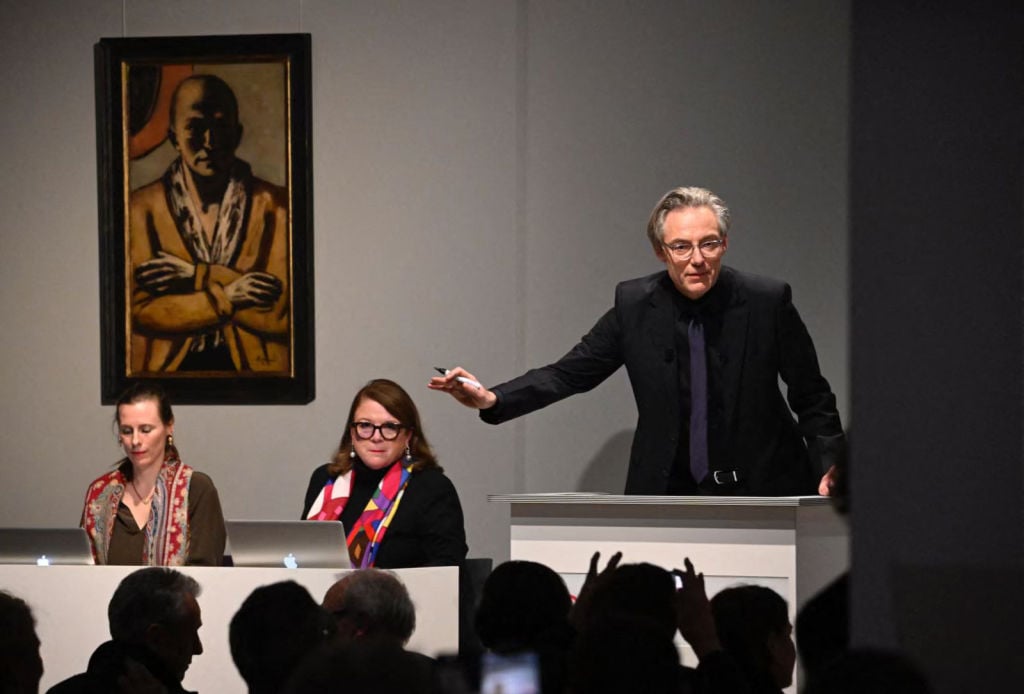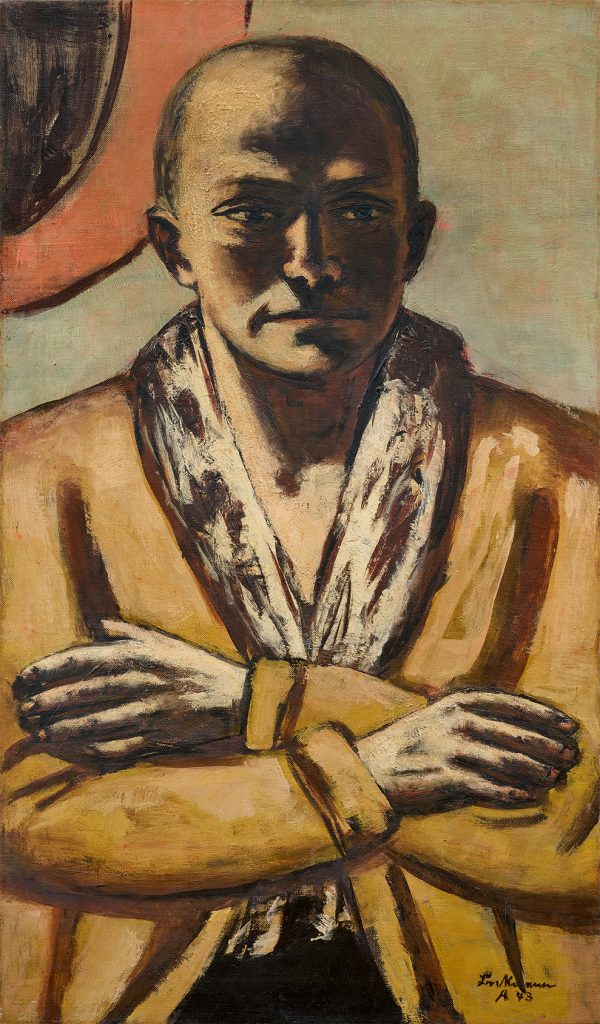Auctions
A $22 Million Max Beckmann Painting Sets a Staggering Record at a German Auction House in a Lively Night of Drama and Intrigue
A work by Kandinsky, which the Polish government alleges was stolen, was also included in the sale.

A work by Kandinsky, which the Polish government alleges was stolen, was also included in the sale.

Kate Brown

The saleroom at Berlin’s Grisebach auction house was filled to the brim with curious onlookers on Thursday evening. The crowd was eager to see an enigmatic self-portrait by Max Beckmann change hands for the second time since its creation, in what would be a dramatic transaction that would set a major auction record in Germany.
The crowd was also there to watch the sale of a work by Russian artist Wassily Kandinsky, part of a cohort of modern art gems consigned by German billionaire Maren Otto. The Kandinsky painting was going up for auction despite requests from the Polish government and its culture ministry to halt the sale, claiming it was stolen from Poland in the 1980s. Grisebach maintains that the sale was legal, although it is now seeking a supplementary legal review.
But the hotly anticipated Beckmann sale managed to eclipse that controversy. The 1943 vivid self-portrait went under the hammer for €20 million ($22 million) or €23.2 million ($24.4 million) including fees—nabbing a sweeping record for a work of art sold at auction in Germany. The previous record was €9.5 million for a Ming dynasty sculpture sold in 2021.
The Beckmann work went to a private Swiss buyer, who had bid over the phone via one of Grisebach’s partners. Selbstbildnis gelb-rosa, (Self-portrait Yellow-Pink), is a remarkable piece of art in many ways: Self-portraits are the most famous of Beckmann’s oeuvre, and this particular work, a brooding picture depicting the artist in a fur-lined housecoat, arms folded in a princely pose, was painted while the German artist was living in exile in Amsterdam after he fled Nazi Germany. He had gifted this painting to his wife, Quappi, who held onto it until she died. It was last sold in 1996.

Max Beckmann, Selbstbildnis gelb-rosa (1943). Photo courtesy of Grisebach.
All told, the night was lively, with several bidders in the room snapping up works. Many had also come to see the star lot of the evening and to hopefully witness a record as the Beckmann piece hung in the balance, with no guarantee. Grisebach partner Diandra Donecker noted to Artnet News that, besides its composition, the uniqueness of the work stems from the fact that it is one of five self-portraits to remain in private hands; they rarely come up for sale, and works he painted in exile are even rarer.
Self-portrait Yellow-Pink had traveled to New York in November before arriving back at Grisebach’s 19th-century villa, located on a historic street in west Berlin. Perhaps it had caught a few American collectors’ hearts: two of Grisebach’s specialists notably switched over to English during the sale of this particular lot.
The painting hung behind auctioneer Markus Krause, who emphasized that it was one of the most beautiful self-portraits made by the artist, noting the rarity of the piece. “This chance will never come again,” he said before he opened the bidding at €18 million.
What followed was a few minutes of slightly awkward bidding as three buyers competed in slow, calculated spurts over the phone. Besides the two specialists on the phones, Grisebach partner and former dealer Bernd Schultz was sitting in the audience speaking on his own cellphone to a Swiss collector, who ended up taking the work after approximately three minutes of bidding. It went under the hammer for €23.2 million ($24.4 million) including fees, which was met with a round of applause.
With fees, the work surpassed the previous record for a Beckmann self-portrait, which was set with the sale of Selbstbildnis mit Horn, (1938), sold at Sotheby’s, New York in 2001, for $22.5 million with fees, according to Artnet Price Database. Grisebach’s sale is now the second highest price achieved for a Beckmann painting; at Christie’s London in 2017, Bird’s Hell (1937–38) sold for £36 million ($44 million), including fees.
The Grisebach sale marks a transformative moment for the German art market, which has exploded in recent years. Sotheby’s returned last year to the country after a hiatus and sales in recent years have been more robust than usual, with more works going for over €1 million. The sale on December 1 is more than double the last record achieved in Germany, by the auction house Nagel in Stuttgart, which sold a Chinese bronze sculpture, dating to 1473, for €9.5 million. The record for a painting sold in Germany is held by Grisebach for its sale of another Beckmann work called The Egyptian (1942), for €5.5 million in 2018.

Wassily Kandinsky
Ohne Titel (1928) © Grisebach
Grisebach’s sale consisted of 56 works in total, which were greatly bolstered by consignments from billionaire Maren Otto, wife of deceased Hamburg business tycoon Werner Otto. The widow consigned 45 lots in total to Grisebach’s winter sales.
Her pieces included a meticulous oil painting by Eduard Gartner depicting an 1843 Berlin street scene. The lot was among the night’s most intense bidding wars, with several phone bidders and those in the room all fighting for the piece, which blew past its high estimate of €150,000. With bids jumping to €20,000 increments, it ultimately went for €460,000 ($482,000) to a phone bidder sitting in the room. Another star of the night was Otto Dix’s Mädchen mit roter Tasche (Girl with red bag), a 1924 watercolor on paper. The fight for this work went on for nearly ten minutes before it hammered for €235,000 ($246,000).
But many eyes lingered on a diminutive watercolor by Wassily Kandinsky, also consigned by Otto.
The Polish government, which had listed the work in Interpol’s database of stolen art, said the piece was stolen from the National Museum in Warsaw on June 14, 1984. The painting is marked on the back with the Polish museum’s stamp. “The painting has ownership markings clearly indicating its origin,” wrote Marcin Król, a Polish consul to Berlin, in a post on Twitter. “Accordingly, any sale of it after the moment of theft cannot be considered an act in good faith.” The work went for €310,000 ($325,000) to a telephone bidder. The German media reported that Król attended the sale.
Grisebach takes its obligation to check authenticity, and provenance very seriously, working with a team of 40 experts. “This examination has also taken place with the greatest care with regard to the Kandinsky watercolor. It emerged that the painting had been in the possession of the consignors for several decades and had already been sold publicly at auction by Sotheby’s in London in the first half of the 1980s,” she noted.
Grisebach’s Diandra Donecker said that the auction house first became aware of “a possible theft from a Polish museum” shortly before the auction through a notification from the Polish Ministry of Culture. “This notification was immediately taken as an opportunity to enter into a further legal investigation. This led to the clear conclusion that there were no legal objections to the auction of the watercolor,” she added.
Although the sale has gone through, Grisebach told Artnet News that it has contacted both the consignors and the purchasers and will coordinate a supplementary judicial legal review by a court in order to obtain a binding clarification.
More Trending Stories: